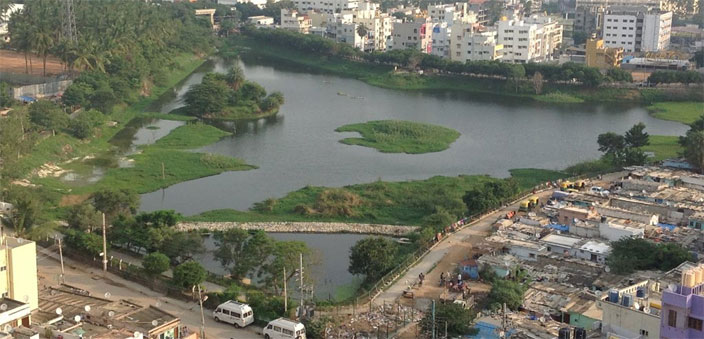Acouple of years back, I was witness to the disappearance of a lake. Enroute my work, in Bangalore, there used to be a small puddle of water surrounded by weeds. Drain water was let into this pool, making it a stinking mess. It was a common scene to see passers-by cover their nose while passing this site. However, things suddenly took a turn for the better, or so I thought. The drainage was diverted, the site levelled off. Soon, a plan for the layout began to develop. And just like that, the water body vanished, making way perhaps for a layout or an apartment complex.
This should not have come as a surprise to me. After all, the Garden City once boasted of 262 water bodies, and more than half of it has already disappeared today. Our city bus terminus is built upon the lake Dharmambudi, the Kanteerava stadium was once Sampangi Lake, our National Dairy Research Institute stands on the Kormangala Lake, and so on and so forth.
An inspiring initiative
But what surprised me was this. Last month I met one of the members of a citizen group – PNLIT. PNLIT stands for Puttenahalli Neighbourhood Lake Improvement Trust. And their story is an inspiring one. They are one of the first citizens group in the city nurturing, maintaining and caring for a lake. And the results are amazing. The Puttenahalli Lake at J.P. Nagar, Bangalore, has integrated with the community very well. Apart from a walking and jogging track, the lake is a hub for various activities such as bird watching, nature walks, tree planting, community gardening, school educational walks etc. Isn’t that wonderful?
A once dying lake converted so beautifully. How was this even possible? These were some of the questions running through my mind.
Ten years ago the lake was a mess. There was an inflow of sewage, dumping of garbage and debris – the lake was disappearing, and the land was slowly getting encroached upon. In short, the lake was soon going to vanish, thanks to pollution and encroachment – a fate shared by 90 percent of city’s lakes.
Fast forward to today, the same Puttenahalli Lake in South Bangalore is teeming with water, and is full of life. There are more than 300 trees growing in its vicinity; birds and butterflies have made it their home. The swamplands have become a nesting ground for many visiting birds. And this is all thanks to the citizens’ efforts and initiatives.
Late in 2008, concerned residents wrote to Lake Development Authorities, led signature campaigns, met the local MLA, and their collective and consistent efforts started yielding results. The lake was brought into the notice of BBMP lake revival list, and the rejuvenation of the lake began in 2009-2010.
In 2011, the BBMP (Bruhat Bengaluru Mahanagara Palike) handed it back to the Puttenahalli Neighbourhood Lake Improvement Trust for maintenance. Since then, with the help of volunteers and donations, the PNLIT has ensured its cleanliness. It holds various events like nature workshops, photography sessions, storytelling sessions, cultural concerts etc. During these events it also shares knowledge about waste segregation, composting, rain water harvesting etc. ‘It is all about building awareness and making the community responsible,’ said one of the trustees of PNLIT.
Here are some of the steps taken by the alert residents.
Initially the litter was cleared, a fence was put up, the lake was desilted, and sides around the lake were raised for a walkway. In 2010, saplings were planted by PNLIT and BBMP to lure the birds back to the lake. The water level of the lake slowly rose due to rains and with the clearing of some of the water inlets. Gradually, grills were added to separate the walkers’ track and the lake; a security guard, gardener and sweepers were employed to keep the area clean and to prevent the dumping of garbage. Apart from several such initiatives, two unique strategies were employed at this South Bangalore Lake:
Artificial floating islands
These work similar to wetlands. The lightweight structures have a variety of plants growing on them. These plants help clean up the lake. Plants such as canna, water spinach, and vetiver grow deep into the water and absorb harmful chemicals. These chemicals could be the result of sewage entering the lake. By absorbing excess nutrients these ensure that oxygen dissolved in the water does not decrease. Thus it helps in reviving aquatic life. Not only that, the islands also turn into a habitat for the birds as well as fish. The lightweight structure is built using PVC pipes, plastic bottles, and a mesh of nylon material.
Volunteers build such islands with nets and release them in water. Plants are grown on these fishing nets. Such structures also make use of trash – used plastic bottles. After releasing these structures, the water quality of Puttenahalli was tested. It was found that the dissolved oxygen had gone up.
Using treated water
Puttenahalli Lake was mainly rainfed. This meant the lake would soon dry up once the monsoons left the city. So to prevent this and to raise the lake levels, the treated water from L & T South City apartment complex was released into the lake after bio filtration. The South City STP treated water was used within the community, gardens and for flushing toilets. The excess water was released to the lake. Thus the lake, and the neighbourhood both benefited from this approach.
The initiatives taken by PNLIT has been an inspiration in the city. Other lake groups too are taking a leaf out of them and coming forward to nurture the lakes. With the success of the revival of Puttenahalli Lake that has become home to aquatic life, migratory birds, butterflies, people are slowly realising the importance of a well-cared lake.
Lakes are not to be seen as just drinking water sources or for city beautification. They do a lot more. They recharge the water table, prevent flooding, and act as a habitat for a variety of birds and animals. So let us act to preserve them.


 [/column]
[/column]